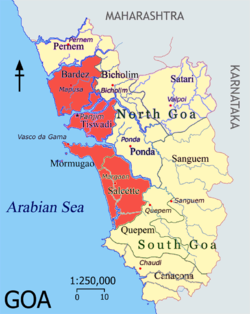This article needs additional citations for verification .(November 2008) |
Novas Conquistas | |
|---|---|
Region | |
 Goa at its height under Portuguese occupation. The Novas Conquistas are highlighted in cream. | |
| Country | Portuguese Empire |
| Region | Estado da India |
| Historical Province | Goa Província do Norte |
| Concelhos | Goa: 7 Província do Norte: 8 |
| Parishes | 25 |
| Capital | Nova Goa (Pangim) |
The Novas Conquistas or "New Conquests" are a group of seven concelhos (municipalities) of Goa and Damaon, officially known as Portuguese India. They were added into Goa in the 18th century AD, comparatively date than the three original concelhos that make up the Velhas Conquistas , or "Old Conquests".
Contents
The seven concelhos of the Novas Conquistas are: [1]
- Pernem,
- Bicholim,
- Sattari,
- Antruz (Ponda),
- Sanguem (modern-day Sanguem and Dharbandora),
- Quepem and
- Canacona.
Silvassa was a newly-acquired area in the Província do Norte.
In writing postal addresses, the Novas Conquistas were abbreviated "N.C."